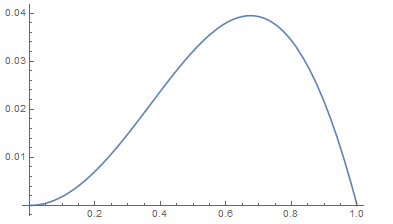In view of the answer by Carlo Beenakker and the comment by Alexandre Eremenko, it appears that what you actually had in mind is the following question:
By the mean value theorem, for each $t\in(0,1]$ there is some $\xi_t\in(1,e)$ such that
\begin{equation*}
r(t):=\frac{\sin et-\sin t}{(e-1)t}=\cos(\xi_t t). \tag{2}
\end{equation*}
(Since $\cos u$ is strictly decreasing in $u\in[0,e]$, the value of $\xi_t$ is unique for each $t\in(0,1]$.)
Is it true that $\xi_t\ge\tau$ for all $t\in(0,1]$?
The answer to this question is yes. Indeed, for $t\in(0,1)$ we have $\xi_t t\in(0,e)\subset[0,\pi]$ and $\tau t\in(0,\tau]\subset[0,\pi]$. Therefore, in view of (2) and because $\cos$ is strictly decreasing on $[0,\pi]$, we see that
\begin{equation*}
\xi_t>\tau\iff d(t):=\cos\tau t-r(t)>0; \tag{3}
\end{equation*}
here and in what follows, $t\in(0,1)$.
Next,
\begin{equation*}
d_1(t):=(e-1) d(t)/t^2=\sum_{j=1}^\infty(-1)^jb_j t^{2j-2}-\sum_{j=1}^\infty(-1)^ja_j t^{2j-2},
\end{equation*}
where
\begin{equation*}
a_j:=\frac{e^{2 j+1}-1}{(2 j+1)!},\quad b_j:=\frac{(e-1) \tau^{2 j}}{(2 j)!}.
\end{equation*}
It is easy to see that $0<a_j<a_{j+1}$ and $0<b_j<b_{j+1}$ for all natural $j$. So,
\begin{equation*}
d_1(t)>-b_1+b_2t^2-b_3t^4+a_1-a_2t^2>0 \quad\text{if}\quad 0<t\le4/5.
\end{equation*}
It remains to prove that
\begin{equation}
d_2(t):=(e-1)t d(t)>0\quad\text{if}\quad 4/5<t<1.
\end{equation}
Since $d_2(1)=0$, it suffices to show that
\begin{equation}
d_2'(t)=\cos t-e \cos et+(e-1) \cos \tau t-(e-1) \tau t \sin \tau t<0
\end{equation}
for $t\in(4/5,1)$.
Since $\cos t,\cos et,\cos \tau t$ are decreasing in $t\in(4/5,1)$ and $\sin \tau t$ is concave in $t\in(4/5,1)$, the desired result follows because for $t\in[t_j,t_{j+1}]$ and $j=0,\dots,n-1$
\begin{equation}
d_2'(t)\le\cos t_j-e \cos et_{j+1}+(e-1) \cos \tau t_j
-(e-1) \tau t_j \min(\sin \tau t_j,\sin \tau t_{j+1})<0,
\end{equation}
where $n:=20$ and $t_j:=4/5+j/(5n)$.
To illustrate the above proof, here is the graph $\{(t,d(t))\colon0<t<1\}$:



